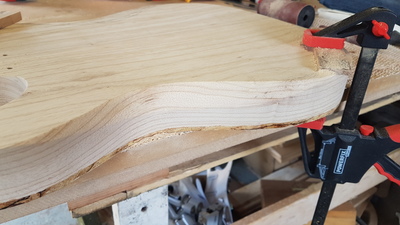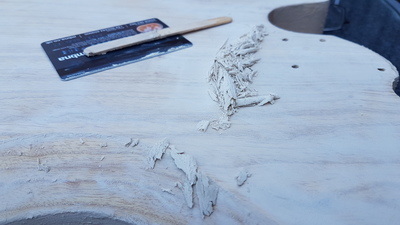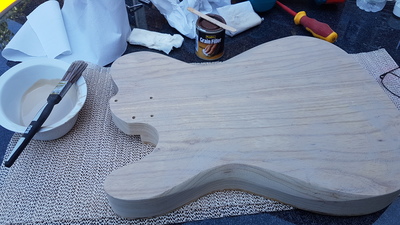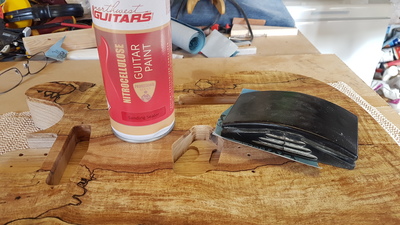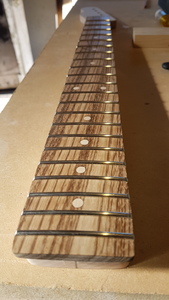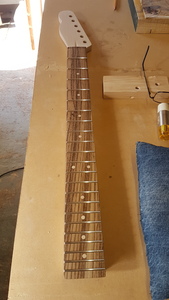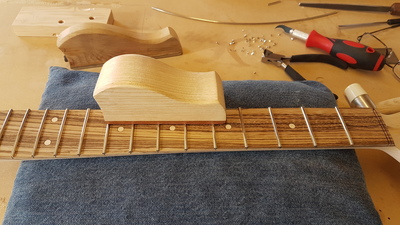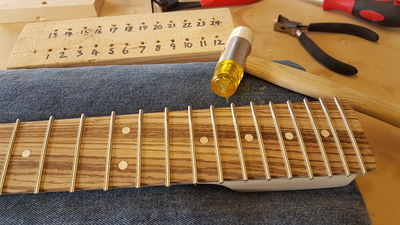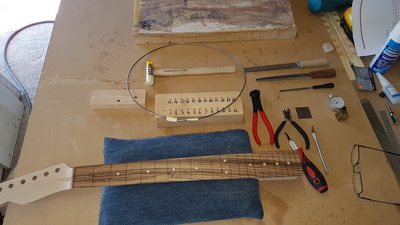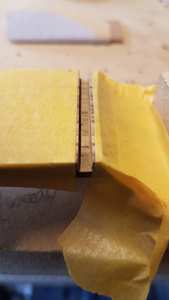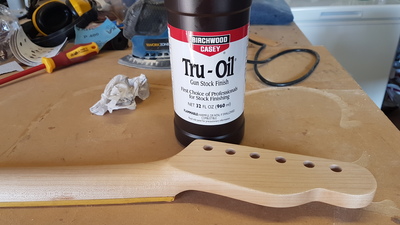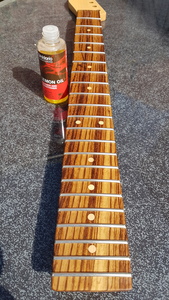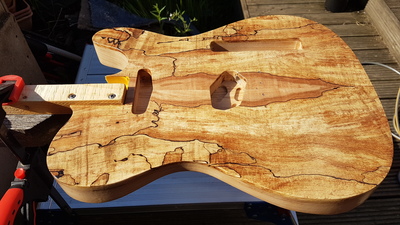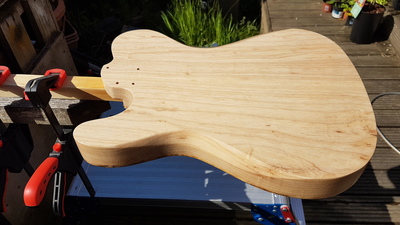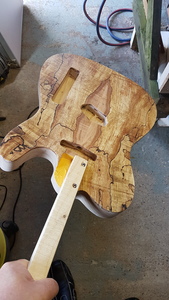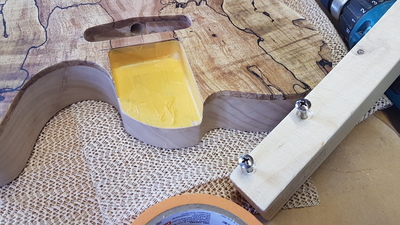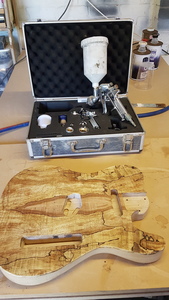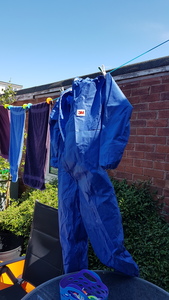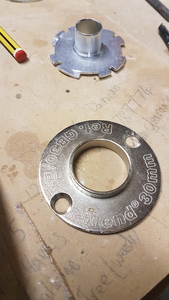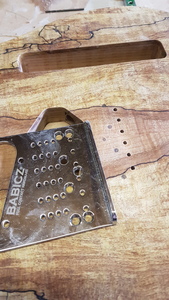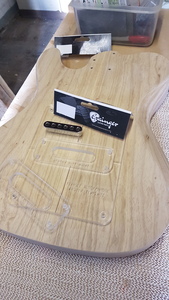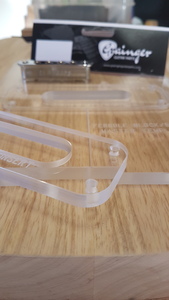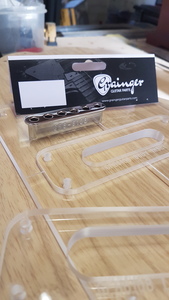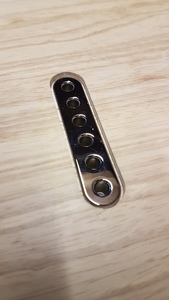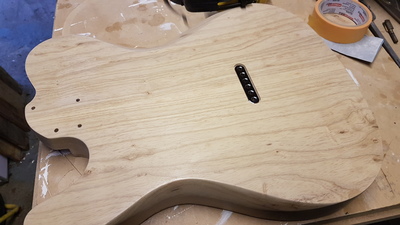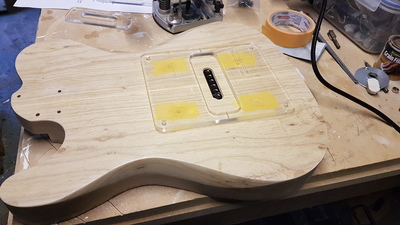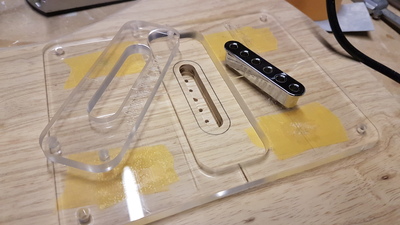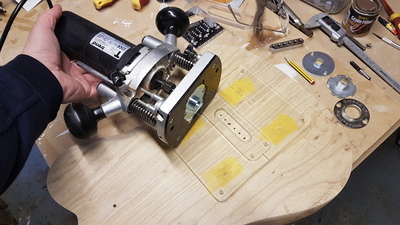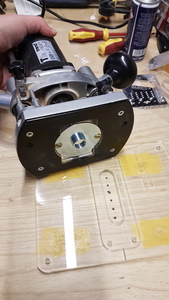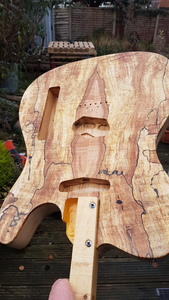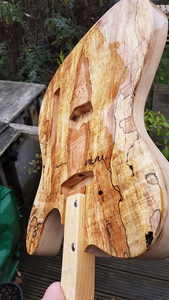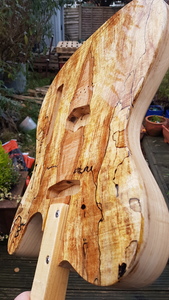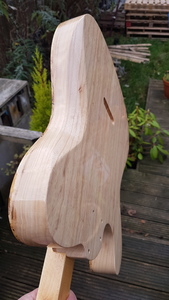Next, a bit of body carving. A belly cut and a knee cut. I used hand tools for this, rasp, files and sandpaper.
Make guitars, not war 🌍✌️🎸
As Ash is an open grain wood, I wanted to use grain filler so I could achieve a high gloss finish with lacquer (I used auto clear coat actually). I applied the filler with a paint brush as I let down with a bit of white spirit to make it easier to apply. Once it started to dry, I used an old credit card to scrape off the excess. When completely dry it was all sanded back through the grades.
Make guitars, not war 🌍✌️🎸
Make guitars, not war 🌍✌️🎸
Make guitars, not war 🌍✌️🎸
I decided to finish the neck in a nice silky smooth Tru Oil gun stock finish so it got many coats. I treated the fretboard with Lemon Oil.
Make guitars, not war 🌍✌️🎸
Time to clear coat the body. I masked up the neck pocket, turned on my air compressor, got my spray gun ready, mixed my lacquer (clear coat), put on my PPE and sprayed the guitar body, two coats.
Make guitars, not war 🌍✌️🎸
I have recently bought a new part for this build. It wasn’t in the design but I changed my mind. I wanted to have the strings go through the body from the back, through the bridge and up to the tuners. In the design I planned for six individual string ferrules to be fitted in the back of the guitar body but then I found this ferrule block from Grainger Guitar Parts. I bought the routing templates as well but I needed an 18mm guide bush for my router as I only had a 30mm one. Note: Bosch don’t do 18mm bushes, I am using one for my Trend router instead.
Make guitars, not war 🌍✌️🎸
Ferrule block cavity routed.
It’s a really good system using these routing templates. The ferrule block itself is of really good quality and I can’t wait to string the guitar up and try it out. When I’ve made Telecasters in the past, I just strung it through the end of the bridge, this is the first time I’ve routed the body so I can string it through the body. I’m liking it.
Make guitars, not war 🌍✌️🎸
I used 2k clearcoat again and I got some fisheye on the front. I’m not sure why but I managed to bury most of it on the second coat. It’s not a perfect finish by any means but I’ll see how it is in about a week and I’ll make a decision then about what to do. I could flatten it down and respray over it again and hope I can bury it further or I’ll sand it back completely and try using a different finish such as shellac, Danish oil, Tru Oil etc.
Here is video:
Make guitars, not war 🌍✌️🎸
Fisheye can be caused by contamination on the surface ( a bit of grease, silicon, or something). One of the ways of dealing with it is just to 'flood' it - effectively burying the offending particle. You can do this by drop filling or applying another coat as you did.
Looks great in the pics! Don't think you'll need the turnips?
Measure twice, cut once...
Yeah, I may have overreacted a bit. It just looked really bad on the first coat. I thought I had cleaned the surface enough before applying lacquer but obviously not, I must have had something on my hands. I did actually put gloves on and my spray suit when spraying but I guess I’d already contaminated it. I may try burying it in more lacquer in a week or so when it’s had a bit more time to cure properly.
Make guitars, not war 🌍✌️🎸
Some thoughts...
- It's difficult for me to tell from here obviously, but some of that might be normal sinkage also - I never expect the first coat to look very good.
- Spalted is notorious as there are bits soft and porous as cork while other bits might be non porous
- Wood is not like metal where the paint just sits perfectly on the surface like its well behaved.
- Wood is like a sponge - you have to wait until its finished doing what its doing before you can flat and polish.
- It always looks better in the morning
We'll have to address all this stuff on the Finishing course - great stuff!
Measure twice, cut once...
I am definitely definitely definitely interested in doing a finishing course. Would you do an online or workshop course or both? Whatever form it takes, sign me up!
I can understand all of the points you have made Mark, I will learn from this.
I have painted many guitars but I’ve never had as many problems as I have had with this one. I think I didn’t really have the knowledge about using spalt that has hindered me, I need more experience with different woods and finishes. It just knocks my confidence when things keep going wrong with the same job, I’ll be glad to get this one finished (as in done).
I think I need to do another build with some woods that are more stable to get my confidence back up again.
Sorry Mark, I’ll try not to bother you with this too much, I’m sure I will sort it out.
Make guitars, not war 🌍✌️🎸




